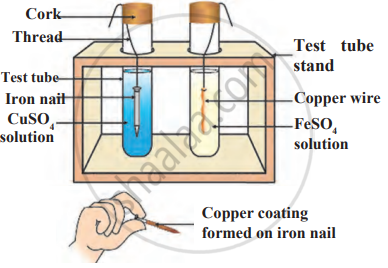Advertisements
Advertisements
Question
How will you obtain Silver chloride from silver nitrate.
Also give balanced equations for the reactions
Solution
When silver nitrate solution reacts with sodium chloride, silver chloride is formed.
Ag `NO_3` + NaCI `→` AgCI + `NaNO_3`
APPEARS IN
RELATED QUESTIONS
Write chemical equation for the event.
Aluminium came in contact with air.
Write chemical equation for the event.
Iron filings are dropped in aqueous solution of copper sulphate.
Write a chemical equation for the following event.
Zinc oxide is dissolved in dilute hydrochloric acid.
Select the correct answer for the statement given below:
A neutral oxide which does not react with an acid or a base to give salt and water.
Explain the following reaction with the balanced equation.
Reaction of aluminium with oxygen
Observe the following diagram and identify the type of reaction and write observation.

An element A reacts with water to form a compound B which is used in white washing. The compound B on heating forms an oxide C which on treatment with water gives back B. Identify A, B and C and give the reactions involved.
Of the three metals X, Y and Z. X reacts with cold water, Y with hot water and Z with steam only. Identify X, Y and Z and also arrange them in order of increasing reactivity.
Arrange the following as per the instruction given in the bracket:
Al, K, Mg, Ca (decreasing order of its reactivity)
Three metal samples of magnesium, aluminium and iron were taken and rubbed with sandpaper. These samples were then put separately in test tubes containing dilute hydrochloric acid. Thermometers were also suspended in each test tube so that their bulbs dipped in the acid. The rate of formation of bubbles was observed. The above activity was repeated with dilute nitric acid and the observations were recorded.
Answer the following questions:
(i) When the activity was done with dilute hydrochloric acid, then in which one of the test tubes was the rate of formation of bubbles the fastest and the thermometer showed the highest temperature?
(ii) Which metal did not react with dilute hydrochloric acid? Give reason.
(iii) Why is hydrogen gas not evolved when a metal reacts with dilute nitric acid? Name the ultimate products formed in the reaction.
OR
Name the type of reaction on the basis of which the reactivity of metals is decided. You have two metals X and Y. How would you decide which is more reactive than the other?
